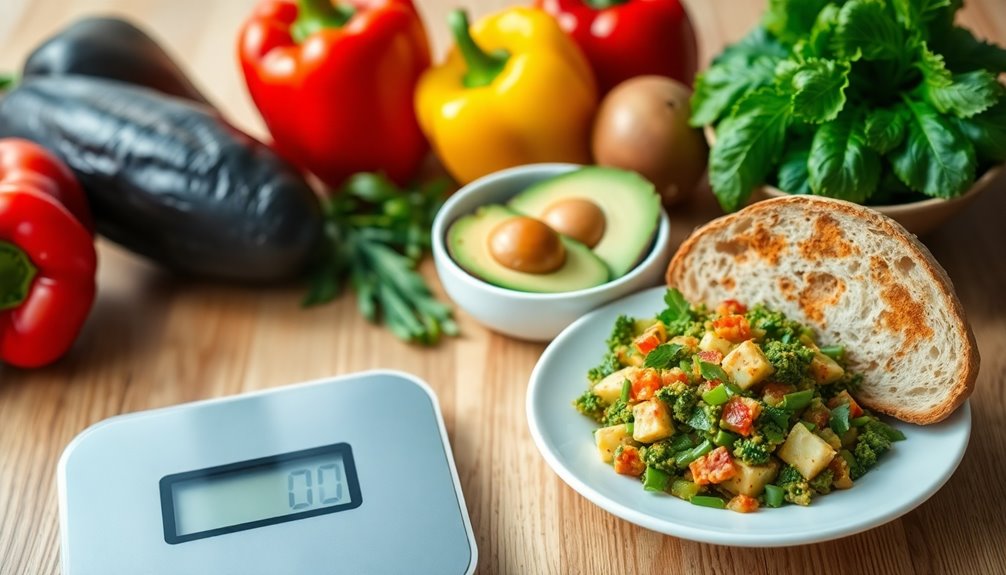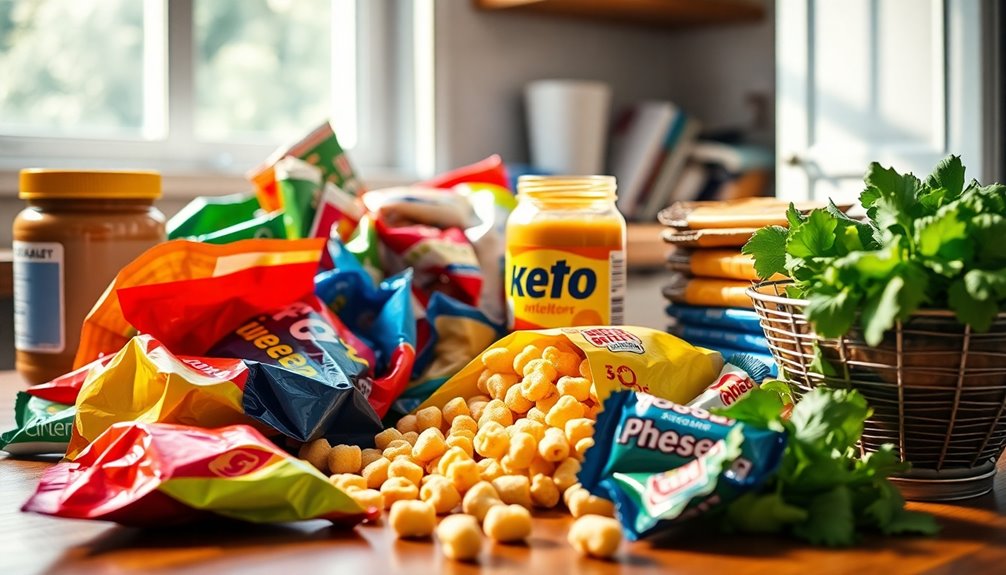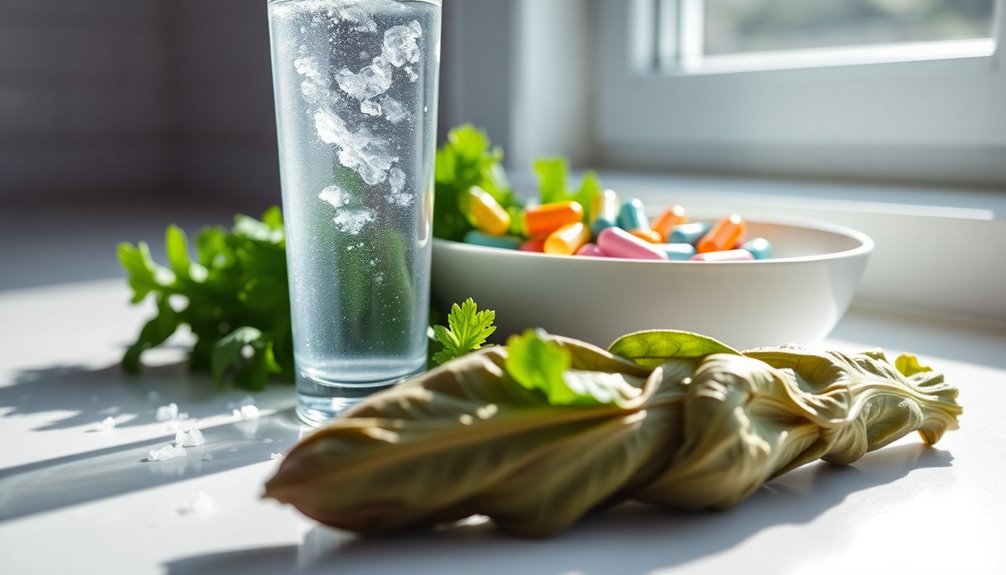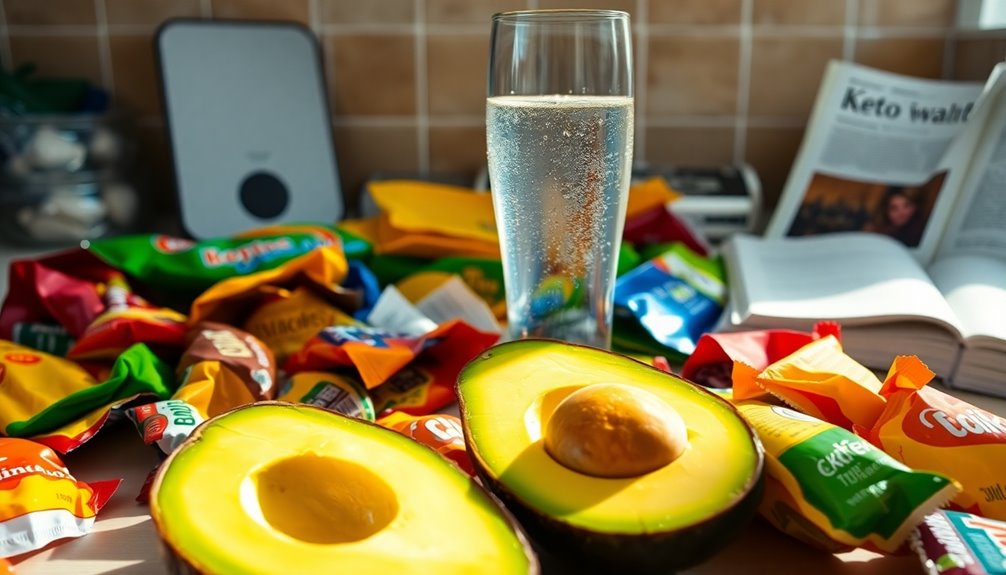When starting keto, you might make some common mistakes that can derail your journey. First, not tracking your macros can prevent you from reaching ketosis. Next, underestimating your carb intake, especially from hidden sources, can sabotage your efforts. Ignoring nutrient balance may lead to deficiencies, while overconsuming processed foods can hinder your progress. Finally, skipping hydration and electrolytes is a mistake that could impact your well-being. By avoiding these pitfalls, you can enhance your success on the keto diet. If you're keen on mastering your keto approach, there's plenty more you should consider.
Key Takeaways
- Not tracking macros can lead to carb overconsumption and hinder ketosis achievement.
- Underestimating hidden carbs in packaged foods, fruits, and condiments can sabotage progress.
- Ignoring nutrient balance may cause deficiencies; meal planning helps maintain a healthy intake.
- Overconsuming processed foods instead of whole foods can derail keto success; prioritize nutrition.
- Skipping hydration and electrolytes can lead to fatigue and imbalances; stay hydrated and replenish electrolytes.
Not Tracking Macros

One of the most common pitfalls for beginners on the keto diet isn't monitoring macros. You might think you're consuming low-carb foods, but without measuring, it's easy to lose sight of your goals. Macro monitoring involves keeping tabs on your intake of carbohydrates, fats, and proteins, which is vital for achieving and maintaining ketosis.
Meal planning can greatly enhance your success on keto. By preparing meals in advance, you gain control over your ingredients and portions, ensuring you stay within your macro limits. Rather than relying on guesswork, you can create a structured menu that aligns with your nutritional needs. This proactive approach not only simplifies your daily choices but also fosters a sense of community as you share your meal ideas with others following the same path.
Portion control is equally important. It's tempting to indulge in high-fat foods, thinking they're always keto-friendly. However, overdoing it can lead to exceeding your calorie intake, making it harder to lose weight. By measuring your portions, you can enjoy your favorite meals without derailing your progress.
In essence, monitoring macros, planning meals, and maintaining portion control can make a world of difference in your keto journey. You're not just following a diet; you're embracing a lifestyle that promotes health and well-being. Remember, you're not alone—many others are navigating these challenges alongside you, striving for success together.
Underestimating Carb Intake

Many beginners underestimate their carb intake, which can sabotage their efforts on the keto diet. When you think you're following the guidelines, hidden carbs can sneak into your meals, preventing you from achieving ketosis. To stay on track, you need to be mindful of your carb sources and portion sizes.
Here are three common pitfalls to watch out for:
- Packaged Foods: Many low-carb or keto-friendly snacks still contain hidden sugars or higher carb counts than you realize. Always read the nutrition labels carefully.
- Fruits and Vegetables: While they're nutritious, certain fruits and starchy vegetables can pack more carbs than you might expect. For example, bananas and potatoes should be limited, while leafy greens are preferable.
- Condiments and Dressings: These can easily add unexpected carbs to your meals. Sauces like ketchup, barbecue sauce, or even some salad dressings can contain sugars that bump up your carb count. Opt for low-carb alternatives or make your own.
Ignoring Nutrient Balance

Nutrient balance is necessary for anyone starting on the keto diet, yet beginners often overlook it in favor of simply reducing carbs. This can lead to deficiencies in essential nutrients that your body needs to thrive. While it's great to cut back on carbs, you also have to pay attention to the quality of the fats and proteins you're consuming.
Effective meal planning can help you achieve a balanced intake of macronutrients and micronutrients. Aim for a variety of foods that provide not just fats but also ample protein and fiber. Incorporate leafy greens, nuts, seeds, and healthy oils like olive or avocado oil into your meals to make sure you're getting a wide range of vitamins and minerals.
Don't forget about food swaps! Instead of opting for processed low-carb snacks, consider healthier alternatives. For example, swap out conventional pasta for zucchini noodles or cauliflower rice, which can add more nutrients without sacrificing flavor. These simple changes can greatly enhance your meals while keeping them keto-friendly.
Listening to your body is crucial; if you feel fatigued or unwell, it might be a sign that you're missing vital nutrients. Remember, the goal of keto isn't just to lose weight but to foster a sustainable, healthy lifestyle. By focusing on nutrient balance, you'll not only feel better but also be more successful on your keto journey. Embrace the process and enjoy discovering delicious, nutrient-dense foods that fit your new lifestyle!
Overconsuming Processed Foods

While cutting carbs is necessary on the keto diet, overconsuming processed foods can derail your progress. Many beginners gravitate towards convenient, pre-packaged items labeled as "keto-friendly," but these often come with hidden sugars and unhealthy fats. It's vital to be aware of what you're consuming and to prioritize whole foods.
To stay on track, consider these three strategies:
- Choose Healthy Alternatives: Instead of reaching for processed snacks, opt for whole food options like nuts, seeds, avocados, and non-starchy vegetables. These alternatives not only provide essential nutrients but also keep you feeling fuller longer.
- Practice Mindful Eating: Pay attention to what you're eating and how it makes you feel. By slowing down during meals, you'll be more aware of your hunger cues and can better resist the urge to snack mindlessly on processed items.
- Read Labels Carefully: When you do buy packaged foods, make it a habit to read the labels. Look for items low in carbs and free from artificial ingredients. This step can help you avoid the pitfalls of hidden sugars and unhealthy additives.
Skipping Hydration and Electrolytes

Staying hydrated is necessary on the keto diet, yet beginners often overlook this important aspect. When you cut carbs, your body releases stored water and electrolytes, which can lead to dehydration. This is where electrolyte importance comes into play. Sodium, potassium, and magnesium are essential for maintaining fluid balance and ensuring your muscles and nerves function properly. If you're not replenishing these electrolytes, you may experience fatigue, cramps, or even headaches.
To avoid these pitfalls, consider some hydration tips. First, aim to drink at least half your body weight in ounces of water daily. For instance, if you weigh 150 pounds, aim for 75 ounces of water. Incorporating electrolyte-rich foods like leafy greens, avocados, and nuts can also help.
Additionally, consider adding electrolyte supplements—especially if you're sweating more than usual during workouts.
Another helpful hydration tip is to start your day with a glass of water and keep a refillable bottle with you throughout the day. This simple habit can remind you to sip regularly. If you're feeling sluggish or notice signs of dehydration, don't hesitate to increase your water intake and add some salt to your meals to enhance your sodium levels.
Frequently Asked Questions
Can I Eat Fruit on a Keto Diet?
Yes, you can eat fruit on a keto diet, but you need to be mindful of fruit restrictions. Many fruits are high in sugar content, which can hinder your progress. Berries like strawberries and raspberries are better options due to their lower carb counts. Keep your portions small and focus on fruits that fit within your daily carb limit. This way, you can enjoy fruit while staying aligned with your keto goals.
How Long Does It Take to Enter Ketosis?
You'll typically enter ketosis within 2 to 7 days of following a low-carb diet, depending on your body's unique ketosis timeline. Factors like your carb intake and activity levels play a role. Once you reach ketosis, you'll enjoy benefits like increased energy, reduced hunger, and improved mental clarity. Staying consistent with your diet helps you achieve and maintain this state, allowing you to fully experience the advantages of ketosis.
What Are the Best Low-Carb Snacks?
Imagine a treasure chest filled with delicious, low-carb snacks that won't derail your keto journey.
Think cheese crisps, nut butter with celery, or homemade kale chips. These keto-friendly swaps keep your cravings at bay while maintaining portion control, ensuring you stay on track.
Don't forget the satisfying crunch of pork rinds or the sweetness of berries in moderation.
Embrace these delightful options, and you'll feel part of a vibrant, health-conscious community.
Is Keto Safe for Everyone?
Keto isn't safe for everyone. Individual restrictions, like dietary needs or preferences, play an essential role in determining if it's right for you. People with certain medical conditions, such as diabetes or kidney issues, should consult a healthcare professional before starting.
It's important to understand your body's unique requirements and limitations. Always prioritize your health and well-being, and don't hesitate to seek guidance when making significant dietary changes.
How Can I Avoid the Keto Flu?
Did you know that nearly 50% of people starting keto experience the so-called "keto flu"? To avoid it, focus on maintaining your electrolyte balance by consuming foods rich in potassium, magnesium, and sodium.
Also, make a gradual shift into the diet instead of diving in headfirst. This approach helps your body adapt without the harsh symptoms.
Staying hydrated and incorporating bone broth can further ease your journey, making it smoother and more enjoyable.
Conclusion
Avoiding these common mistakes can make your keto journey smoother and more enjoyable. By tracking your macros, being mindful of carb intake, balancing nutrients, choosing whole foods, and staying hydrated, you'll set yourself up for success. Research shows that these practices not only enhance weight loss but also improve overall health. Embrace these strategies, and you'll likely find keto to be a sustainable and rewarding lifestyle change that truly works for you.



